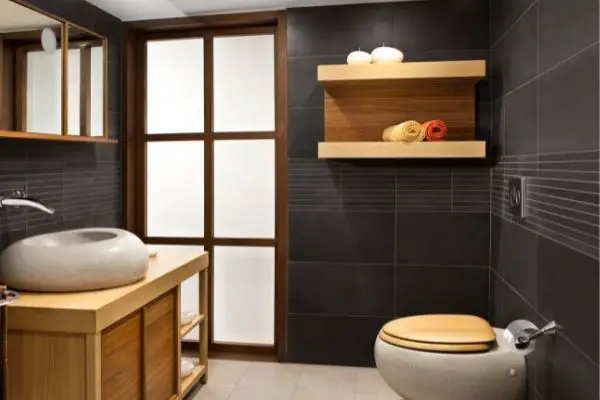Incinerator Toilet Vs Composting – Which Do You Prefer, Ashes or Soil?
It’s no surprise that composting toilets are gaining momentum outside of the RV, tiny home, and sailing communities.
Even suburban homeowners are jumping on the opportunity to minimize water consumption and become self-sufficient with these innovative bathroom fixtures.
But did you know that composting toilets are not the only eco-friendly system available? Incinerating toilets are an equally great — if not better — option for many households.

Though the functional differences between a composting toilet vs. incinerating toilet are vast, these systems achieve almost identical end goals. Choosing one over the other often just comes down to personal preference.
Interested in learning more about these waterless toilets? Keep reading to discover what sets them apart (plus what they have in common)!
What is an Incinerator Toilet?
Incinerating toilets use high heat to burn human waste into dry, lightweight ash. This ash is biodegradable, odorless, and safe to handle. The incineration process occurs within the toilet itself and all fumes are safely vented outside.
A little bit like having a fireplace.
What is a Composting Toilet?
Composting toilets are another popular alternative to flushable models. But instead of high temperatures, these toilets promote quick and sanitary decomposition with the help of natural bacteria.
Composting toilets work just like a backyard compost pile but store all waste completely out of sight until it is fully broken down into dry and odorless humus.
Incinerator Toilet vs Composting Toilet Comparison

Water Consumption
One thing both incinerating and composting toilets have in common is a lack of reliance on water.
Incinerator toilets do not use any water.
Some composting toilet systems use a very small amount of water to wash waste down to the lower chambers. The vast majority use no water at all.
Regardless of the system you choose, this equals fewer utility expenses and a lesser strain on the environment. It also means both types of toilets can be highly portable.
Power Source
When choosing between an incinerating toilet vs. a composting toilet, power needs are a major concern.
There are power-operated versions of incinerating and composting toilets. Neither system consumes a significant amount of electricity. A small generator or renewable power source (i.e., solar panels, etc.) will suffice in most cases.
Composting toilets often rely on electricity primarily to ventilate the system — the toilet can still “operate” without power. But there are some models of composting toilets that require zero external power.
In contrast, incinerating toilets cannot function without a consistent power source. There’s no getting around it, even if the average consumption is very limited.
The one alternative to an electric-powered incinerator toilet is a propane or natural gas system. These systems rely on small fuel tanks rather than electricity, which may be more feasible for those living off the grid.
Maintenance Needs
On average, incinerating toilets must be emptied about once per day. Composting toilets only need to be emptied every few weeks (or even months).
Meanwhile, you’ll do less cleaning with an incinerator toilet vs. a composting toilet. Incinerating toilets feature paper bowl liners that collect bathroom waste before being “flushed” down into the incinerator itself. This naturally keeps the bowl clean without any work on your end.
Byproduct Disposal
An incinerating toilet transforms human waste into ash. Composting toilets break down human waste into humus.
Both byproducts are odorless and sanitary.
The most common ways to dispose of the byproduct from an incinerating toilet is to place it in the household garbage or add it to a non-edible garden. The incineration process means that there is very little of this byproduct left over compared to what goes into the toilet.
The humus produced by a composting toilet can also be added to the soil of non-edible plants. The humus is able to continue breaking down and will eventually re-enter the environment completely.
Size
If you’re looking for the smallest or lightest toilet around, then a composting system is your best bet. Composting toilets are the go-to choice for RV owners and sailing enthusiasts.
Keep in mind that small composting toilets tend to have limited capacities and rely on hand-cranking. Composting toilets with large capacities and powered ventilation systems can be as big — or even bigger — than the average incinerating toilet.
Cost
It’s possible to purchase a composting toilet for much cheaper than the average incinerator toilet. These models tend to be small and may not have powered ventilation systems.

High-end, large-capacity systems of either kind can easily cost $2,000 or more.
The cost to maintain each system and replace consumables like toilet bowl liners or bulking materials is very similar.
Sustainability
Don’t be mistaken: Both incinerating and composting toilets are much more environmentally friendly than their flushing counterparts.
But is one more sustainable than the other?
When you account for things like fuel consumption, single-use liners, and the final byproduct, most people view compostable toilets as being more sustainable than incinerating ones.
Frequently Asked Questions
Does an incinerating or composting toilet require a septic tank?
No! Regardless of composting toilet vs. incinerating toilet, there’s no need to worry about plumbing going to or from your new toilet. Both incinerating and composting toilets are completely self-contained. There is no wastewater and, therefore, no need for a connected septic tank.
Is there an odor difference between composting vs. incinerating toilets?
Neither toilet system will smell bad as long as it is properly maintained. As for what small amount of bathroom odor is inevitable (even with a traditional flushing toilet), there is not much difference between the two.
With an incinerating toilet, you may notice a slight odor immediately after it has been used — this is because the waste has not yet been incinerated. If you opt for a composting toilet, then you’re more likely to notice an odor immediately outside of the system vent.






